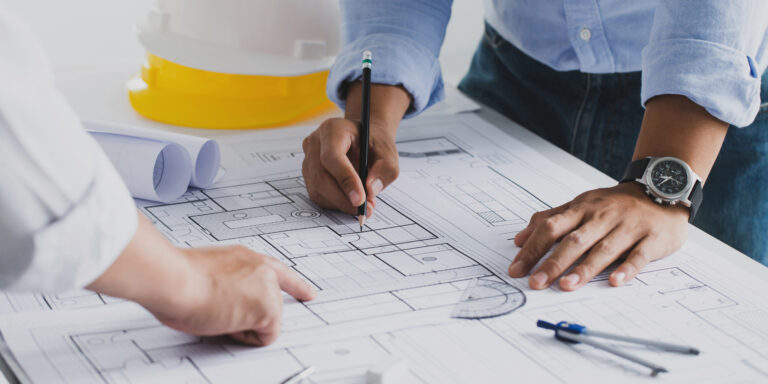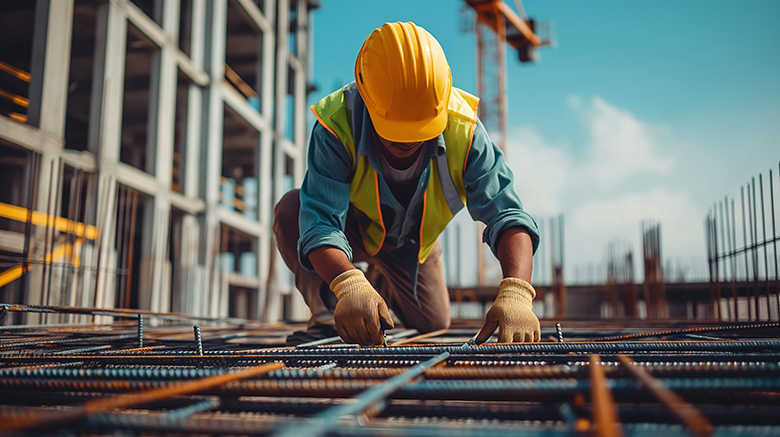— 9 min read
Building Codes Explained: Navigating The Maze of Construction Standards
Last Updated Sep 10, 2024
Last Updated Sep 10, 2024

When new structures are completed, people want to feel confident that they will stay standing and operate well. This is where building codes help.
Building codes are guidelines that outline the minimum requirements to which the structure and its performance must adhere. When the building is up to code, all the various components of the building should be able to operate well together. Foundations should hold up, electrical systems should prevent fires — and occupants should have peace-of-mind.
Plus, modern building codes can help with things like energy efficiency and mitigating the fallout after a natural disaster. FEMA reports that over a 20-year period, building codes helped to prevent $132 billion in natural disaster losses.
That’s why jurisdictions across the country adopt building codes and require construction professionals to adhere to them.
Table of contents
ICC 101: The Global Source for Model Codes
To clarify what standards building codes adhere to and how they shape what happens on the jobsite, it helps to start with a zoomed-out perspective.
The International Code Council (ICC) is an association of global construction safety professionals. It has been operating as one large organization for more than 30 years and is the go-to source for building codes.
The ICC issues a myriad of codes and standards that are adopted in some form by members in more than 40 countries, including the United States. Called International Codes, or I-Codes, these guidelines span a number of disciplines across the construction industry, in many cases aligning with Construction Specifications Institute (CSI) MasterFormat divisions.
Specifically, the ICC issues all of the following building codes, plus others:
The ICC also issues commentary along with its codes in an effort to clarify sections that could otherwise be unclear.
The guidelines laid out in the IBC, IRC, and other I-Codes shape a lot of the regulations in the construction industry today. That doesn’t mean, however, that these codes are directly implemented by the federal government. Instead, I-Codes — which are often also called model codes — get used as a template for local codes.
State and Local Building Code Implementation
As the ICC releases new versions of I-Codes, many states review, amend, and eventually adopt them.
This adoption process usually takes a few years. As of the beginning of 2024, for example, the ICC reported that many states had adopted the 2021 version of the IBC, but some were still using the 2018, 2015 and even the 2012 versions.
Usually, the state adopts a version of the code with its own amendments and omissions based on what’s locally applicable. Other states choose not to adopt an overarching version of an I-Code and instead let local jurisdictions handle adoption.
State code adoption is only intended to provide guidance to municipalities. In the U.S., counties — and in some cases, cities — are the authority having jurisdictions (AHJs) when it comes to building codes. Counties generally adopt their own amended version of I-Codes.
Whether the city or county is the AHJ, they usually have a building department tasked with overseeing compliance. That’s often helmed by a chief building official, a highly credentialed and licensed individual.
How Construction Professionals Shape Building Code
This isn’t to say that contractors have no say in building codes. In some cases, contractors will gather together to push their jurisdiction to make a certain amendment to the local code. They might petition to have a specific section removed because they argue it isn’t locally relevant and creates more work and expense for them.
They might also get involved to encourage the local AHJ to move slowly in adopting new codes. The more time that passes between code adoptions, the less construction professionals have to change how they work to adhere to new requirements.
Even when those lobbying efforts go unheeded, locally adopted building codes don’t necessarily tie their hands.
These codes don’t tell professionals how to do their jobs. Instead, they lay out the performance and safety standards that the structure needs to meet. It’s up to the individuals on the jobsite to determine the means and methods for getting the stamp of approval required from the local building inspector.
Enforcing Building Codes
Building code enforcement happens on a local level. The applicable city or county building department has a team of inspectors who go out to projects as they’re underway. It’s the inspector’s job to confirm that construction is happening in compliance with the locally adopted code.
These inspectors generally have to maintain certification, meaning they’ve met the requirements (e.g., work experience) and passed the applicable exams for the type of inspection work they’re doing.
The Building Code Compliance Process
Generally speaking, the local building department gets involved in code compliance in the preconstruction phase of the project. Their involvement begins when the team on the project files for a permit or permits.
The AHJ then generally performs a code review based on the drawings and specifications. This helps them determine whether to issue the requested permit(s) or not. In many cases, there’s back-and-forth between the building department and the applicant to resolve issues so the permitting can move forward. Because getting permits costs time and money, it’s important for the requirements here to be clearly laid out in the project’s general conditions.
Once the project gets approved by the building department and breaks ground (or begins the renovation), it generally needs to follow a strict inspection schedule laid out by the local AHJ. That AHJ might require inspections for all of the following categories of work:
- Sewer
- Footings
- Foundation
- Framing
- Envelope Inspection
- Electrical
- Plumbing
- Mechanical
- Insulation
- Final Inspection
In some jurisdictions, projects are required to get an inspection after a certain length of time (such as 90 days) to keep their permit open, even if work hasn’t progressed to a new phase that would need an inspection.
At each of the required inspections, the inspector refers to the applicable locally adopted building code. When inspecting the electrical system, for example, they’ll look at their electrical code, most likely modeled off the state’s adopted version of the IEC model code.
For larger projects, multiple inspections may be required for one work category. On a sizable commercial build, for example, the AHJ may require a pre-pour inspection for different sections of concrete being poured on different days.
If the inspector discovers an issue at any point during any inspection, the team on the project needs to correct it and schedule another inspection. The project generally can’t move forward until that inspection is passed.
The processes used to report issues discovered during inspections vary. In some jurisdictions, if a project fails inspection, the inspector will hand over documentation indicating where code wasn’t met. They may even call out the applicable section of local building code. In others, the project manager is simply notified that the inspection was failed. It’s up to their team to determine where they might have fallen short.
Final Inspection
Once construction is complete, the building inspector conducts a final inspection.
When the final inspection is passed and the inspector determines that the building is up to code, they issue a certificate of occupancy (or for additions and demolitions, a certificate of completion). The certificate of occupancy indicates that the building is safe to start operating for its intended commercial, residential, or mixed-use purpose.
At that point, that information goes to the local tax assessor. If a certificate of occupancy was issued, for example, the owner generally needs to start paying taxes. If a certificate of completion was issued for a demolition, the tax bill consequently adjusts downward for the taxpayer.
Third-Party Inspections
Because inspection practices aren’t necessarily consistent across AHJs — and because the process to get those inspections scheduled and completed can be lengthy — some stakeholders schedule their own with third-party inspectors. The contract documents usually call out when third-party inspectors need to come into play.
These independent inspectors are typically highly credentialed and licensed experts. Because the owner or general contractor is paying for their services, they can generally get to a jobsite and complete the required inspection rapidly.
Stakeholders on the project log these inspection reports as a due diligence measure to independently validate that the building is code-compliant. This helps them lessen their liability if an issue should ever arise in the future.
Digitalization of Permitting
The construction industry is slowly, but progressively shifting towards digital, cloud-based permitting and issuing of building codes, driven by the need for increased efficiency, transparency and accuracy. Traditional paper-based processes are being replaced with digital platforms that streamline the submission, review and approval of permits.
These platforms facilitate real-time communication between stakeholders, reducing delays and ensuring compliance with the latest building regulations. Digital tools, such as Building Information Modeling (BIM) and cloud-based project management software, enable automatic updates and track changes, building better coordination and minimizing errors.
Stay updated on what’s happening in construction.
Subscribe to Blueprint, Procore’s free construction newsletter, to get content from industry experts delivered straight to your inbox.

The Ever-Evolving State of Building Codes
A building code spells out features and performance standards that buildings need to have to be safe and functional for their occupants. And as experts learn new ways to protect people and build better structures, building codes will continue to evolve. The ICC, state building authorities and local building departments all continually adjust building codes.
In light of the increasing frequency and severity of hurricanes and other storms, for example, the ICC has adapted the I-Codes to require that wood-to-wood connections along roof lines have metal connector pieces (e.g., hurricane clips, long structural screws). The code doesn’t call for any specific piece of hardware. Instead, it provides a table of the required rating of approved uplift connectors in pounds based on the roof’s specifications.
Similarly, the ICC and other building safety experts determined that in recent years, many house fires have been caused by power arcs (essentially, the electricity jumping out of alignment to places it shouldn’t go). As a result, the IRC has replaced the requirement for over-current breakers with a requirement for arc-fault circuit interrupters in the majority of residential room types.
Was this article helpful?
Thank you for your submission.
0%
0%
You voted that this article was . Was this a mistake? If so, change your vote here.
Scroll less, learn more about construction.
Subscribe to The Blueprint, Procore’s construction newsletter, to get content from industry experts delivered straight to your inbox.
By clicking this button, you agree to our Privacy Notice and Terms of Service.
Categories:
Tags:
Written by
D. Jesse Mase
D. Jesse Mase has a wealth of experience spanning architecture, construction, and real estate investment. His passion for the built environment led him to self-employment as a design builder, and later, managing large-scale commercial construction projects at Trehel Corporation. Currently, Jesse leverages his industry insights in his role as Principal Strategic Product Consultant at Procore, streamlining processes and solutions for construction project owners.
View profileKacie Goff
55 articles
Kacie Goff is a construction writer who grew up in a construction family — her dad owned a concrete company. Over the last decade, she’s blended that experience with her writing expertise to create content for the Construction Progress Coalition, Newsweek, CNET, and others. She founded and runs her own agency, Jot Content, from her home in Ventura, California.
View profileExplore more helpful resources

Mitigating the Impact of Tariffs in Construction
The construction industry faces constant financial uncertainty, and the 2025 escalation of global tariffsmandated by executive order drew attention to their potential impacts. While no crystal ball can tell exactly when...

Using Construction Benchmarking for Better Project Outcomes
Successful construction teams consistently work toward getting better at what they do — producing better quality projects, reducing waste and delivering work on time and on budget. Construction benchmarking provides...

How to Understand and Use Architect’s Supplemental Instructions
Architect’s supplemental instructions, also known as ASI, offer a means of making small changes to the construction contract after it’s signed. The ASI is a document issued by the architect...
Improving Project Monitoring with Construction Quantity Tracking
Once a construction project is underway, builders need to closely monitor the project’s progress and make sure it’s staying on schedule and within budget. Quantity tracking helps construction leaders manage...